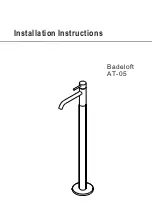
10
10.
SENSOR MOUNTING AT COLLECTOR
The controller heat sensor is mounted to the nipple
outlet of the collector (Figures 14). A stainless steel
screw clamp should be used. The entire nipple
should be wrapped thoroughly with insulating tape
so that the sensor is isolated from the outside air.
Figure 14
11.
PIPING THROUGH THE ROOF
Piping through the roof should be weatherproofed
as shown in Figure 15.
(a)
One inch holes are drilled through the roof on
the same plane as the supply and return header
nipples. Do not drill the hole above the supply
header of the collector. This will prevent the
collector from draining. Placing the hole below
the supply header is acceptable, but it is more
aesthetic if it is located on the same plane
(b)
A copper flashing is placed around the hole
with its base cemented to the roof and its upper
edges slid under the adjoining shingle.
(c)
The copper tube supply and return line is then
pushed up through the hole in the flashing.
(d)
A “coolie cap” is then slid over the copper tube
till it meets the flashing. After piping to the
collectors is completed, the “coolie cap” is
soldered to the copper tube.
(e)
Polybutalyne adhesive is then placed on the top
and bottom of the flashing, providing a
weatherproof seal. The sensor wire should also
be run through the return flashing.
Figure 15
12.
STORAGE TANK PLACEMENT
To minimize expense and heat loss, the tank should
be placed near the collectors and central to points of
greatest water demand. It should be located in as
warm a spot as possible. It should be located with
adequate ventilation, with a minimum of 6-8 inches
of clearance and with ready access to controls and
serviceable parts.
Provision should be made to prevent water damage
in case of leakage. A catch pan with a minimum of
¾” drain line at least 2” in height may be installed
and pitched for proper drainage. Electrical service
of 240V should be available for the element and
110V for the pump and controller.

































